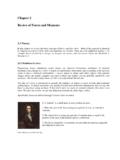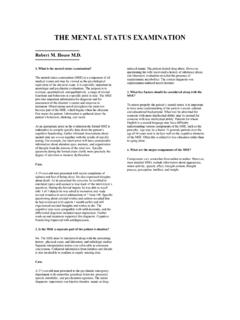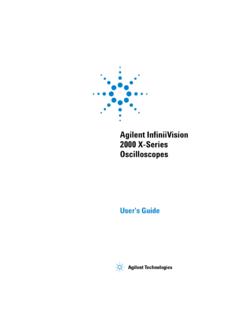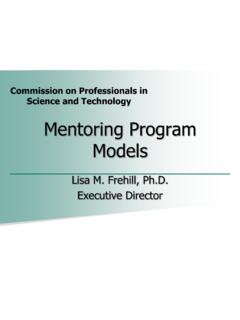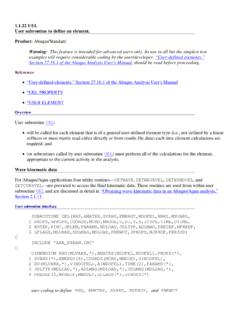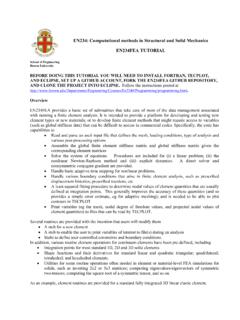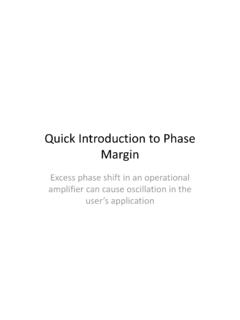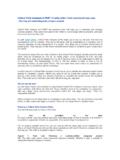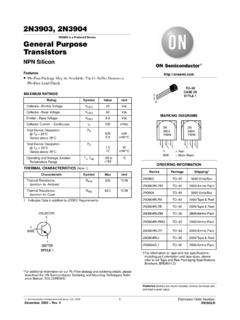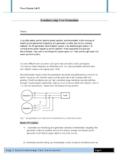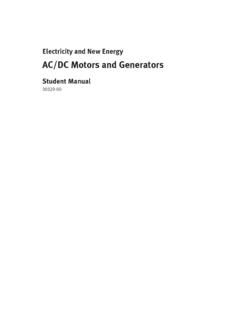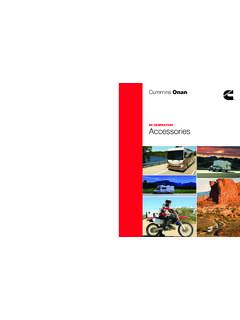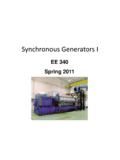Transcription of AC Electrical Generators - Brown University
1 BASIC AC Electrical Generators FREE DOWNLOAD (This page left blank intentionally) BASIC AC Electrical Generators TABLE OF CONTENTS Introduction .. 1 Generator Types .. 4 Rotating Armature Generator .. 4 Rotating Field 5 Polyphase Generators .. 7 Air Cooled Generators .. 10 Temperature Rise .. 10 11 11 Generator Design and Construction .. 11 Generator Stator and Windings .. 11 Stator Design Hydrogen/Water Cooled Stators .. 17 GENERATOR ROTORS .. 19 Salient Pole Rotors .. 19 Cylindrical Generator Rotor .. 20 Rotor Design Air Cooled 25 Rotor Design Hydrogen/Water Cooled Generators .. 27 Rotor Mechanical Design .. 29 Hydrogen Cooled Generator Stator .. 31 Generator Isolated Phase 33 Standard Generator Seal Oil System.
2 35 Standard Generator Stator Cooling Water System .. 43 BASIC AC Electrical Generators Excitation Systems .. 49 Progress Check .. 52 Answers .. 56 Final Examination .. 58 BASIC AC Electrical Generators (This page left blank intentionally) BASIC AC Electrical Generators PREFACE Thi s trai ni ng mod ule has been developed to provide you with i nformation pertai ning to devices known as Basic AC Elect ri c Ge nera tors . The i nfo rmati o n i n t hi s traini ng module is designed to i ncrease your knowledge and improve your abilities as the y re late to the module. Wi t hi n t he trai ning module you will find information pertaini ng to various designs of Electrical Generators , code requirements, associated accessories, as well as related mathematical pri nciples and their solutions.
3 Additiona lly, the t rai ni ng mod ule includes associated review questions and answers so that you can gauge your comprehension of the subject material. Subject matter within the mod ule he lps prepares the student to take related state, city, and American Society of Power Engineers Licensing exams. Information contained in this lesson has been obtained by O&M Consulting Services Inc from sources believed to be reliable. Neither however O&M Consulting Services Inc nor its authors guarantee the accuracy or completeness of any information published herein, and neither O&M Consulting Services Inc and its authors shall be responsible for errors, omissions, or damages arising out of use of this information.
4 This work is published with the understanding that O&M Consulting Services Inc and its authors are supplying information but are not attempting to render engineering or other professional services. If such services are required, the assistance of an appropriate professional should be sought. O&M Consulting Services Inc has supplied American Society of Power Engineers Inc with this Training Module at no charge for free distribution. This document may not be resold; it is for informational purposes only. BASIC AC Electrical Generators (This page left blank intentionally) BASIC AC Electrical Generators - 1 - Introduction Faraday s Law; when you see that rotation of the coil conti nually changes the magnetic fl ux t hro ug h the co i l a nd t herefo re generates a voltage.
5 Ge nerators, mo tors, transformers, and solenoids each use the pri nciple of electromagnetism. This is the ability to create Electrical current in a conductor by moving a magnetic field past the conductor. The reverse is also true: a magnetic field is produced in a conductor by passing Electrical current through the conductor. In general, the requirements for electromagnetism are a magnetic field, a conductor, and relati ve movement between the m. A permanent magnet has a magnetic field around it. The field is lines of magnetism (flux) that bend around the metal magnet. The strongest part of the magnetic field is the region where the li nes are closest together. On a permanent magnet, there are two such regions, one at each end of the magnet.
6 These are called the nort h and so ut h poles of the magnet. (The earth is a magnet, with the strongest part of the magnetic field at the North and South Poles Magnetic of the earth.) A simple generator has two basic parts field and wi nding. The field is the magnetic fie ld and the wi nding is the conductor formed i nto a coil. The field is connected to a shaft that may be turned. These are two elements necessary for electromagnetism. When the turning field is placed near the windi ng, all of the elements are present for electromagnetism. (In fact, the field could be fixed and the wi ndings turned to produce the same effect i n a generator. However, this S N Fie ld Winding BASIC AC Electrical Generators - 2 - arrangement is normally used for small Generators , where the current produced in the winding is small.)
7 As the field turns past the fixed windi ng, the amount of current produced i n the wi nding depends upon the strength of the magnetic field moving past the winding. As the North Pole of the field moves past the wi nding, a large current flows through the winding. As the field continues to turn and the North Pole starts to move away from the windi ng, the current decreases as the strength of the field cutti ng the wi nding decreases. When neither pole is nearest the wi nding, the current through the wi nding is zero. As the field continues to turn, the South Pole moves toward the windi ng as the North Pole moves away. Current starts to flow in the wi nding, but i n the opposite direction, because of the opposite pole movi ng closer to the wi nding.
8 When the South Pole is opposite the wi nding, the current is again strong, but in the opposite direction. S N Fie ld Winding S N Fie ld Winding S N Fie ld Winding BASIC AC Electrical Generators - 3 - As the South Pole moves away, the current i n the winding decreases, returni ng to zero again when neither pole is close to the wi nding. While this simple generator produces AC (alternati ng current), the current produced is not very large since the strength of the magnetic field is not very large. The principle of electromagnetism may be used to produce a magnetic field of much greater strength. If a co nd uct or is wound around a piece of metal, such as iron or steel, and current is passed through that conductor, a magnetic field is produced around this assembly.
9 It is called an electromagnet. The strength of the magnetic field produced is determi ned by the amount of current passing through the conductor. When a stronger magnetic field passes a windi ng, more current is produced i n the winding. In a generator, the amount of current produced i n the wi nding can thus be controlled by controlli ng the amount of c urre nt passi ng t hro ug h the co nduc tor ca usi ng the mag neti c fi eld. The three-phase generator is basically three separate Generators i n one casing. It has three completely separate wi ndings i n which current is produced, but a single rotating magnetic field. Withi n the generator, there is no Electrical connection between the wi ndi ngs.
10 The rota ti ng mag neti c fi eld i s t he rotor a nd t he wi ndi ngs i n w hi ch c urre nt i s produced are in the fixed stator. N S N S BASIC AC Electrical Generators - 4 - Generator Types Various types of alternating current Generators are utilized today; however, they all perform the same basic function. The types discussed i n the following paragraphs are typical of the more predominant ones in use. Rotating Armature Generator In the rotating armature AC generator as illustrated in Figure 1, the stator provides a stationary electromagnetic field. The rotor, acti ng as the armature, rotates i n the field, cutting the lines of force and producing the desired output voltage. The output voltage is taken from the rotor by the slip rings and brushes.
